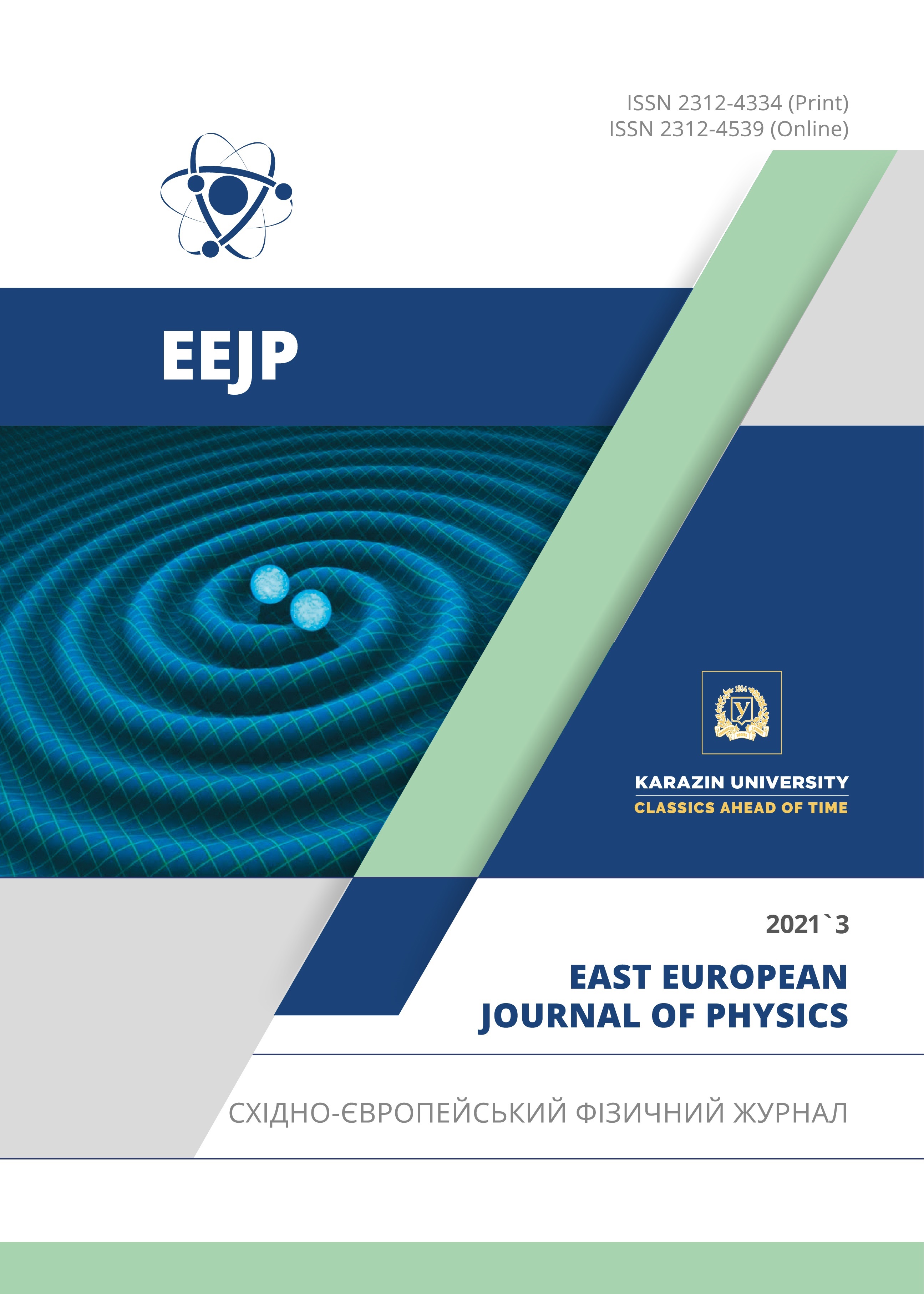Tensoelectrical Properties of Electron-Irradiated N-Si Single Crystals
Abstract
Tensoresistance at uniaxial pressure for electron-irradiated n-Si single crystals at room temperature has been studied. Silicon single crystals for research were doped with phosphorus, concentration Nd=2.2·1016 cm-3, and irradiated by the electron flows of 5·1016 el./cm2, 1·1017 el./cm2 and 2·1017 el./cm2 with the energy of 12 MeV. Measurements of tensoresistance and Hall constant were performed for the uniaxially deformed n-Si single crystals along the crystallographic directions [100] and [111]. Mechanisms of tensoresistance for the investigated n-Si single crystals were established based on the measurements of the tenso-Hall effect and infrared Fourier spectroscopy. It is shown that the tensoresistance of such single crystals is determined only by changes in the electron mobility under the deformation. In this case, the electron concentration will not change under the action of uniaxial pressure, because the deep levels of radiation defects belonging to the VOi VOiP complexes will be completely ionized. Ionization of the deep level of EV+0.35 eV, which belongs to the defect of CiOi, under the deformation will not be manifested and will not be affect on the tensoresistance of n-Si. It is established that the anisotropy of electron scattering on the created radiation defects, which occurs at the uniaxial pressure along the crystallographic direction [100], is the cause of different values of the magnitude of tensoresistance of n‑Si single crystals, irradiated by different electron flows. For the case of tensoresistance of the uniaxially deformed n-Si single crystals along the crystallographic direction [111], the dependence of its magnitude on the electron irradiation flow is associated with changes in the screening radius due to an increase in the effective electron mass. For the first time obtained at room temperature the increase of the magnitude of tensoresistance for the n-Si single crystals due to their irradiation by the electron flows of Ω ≥1·1017 el./cm2 can be used in designing high uniaxial pressure sensors based on such n-Si single crystals with the higher value of tensosensitivity coefficient regarding available analogues. Such sensors will have increased radiation resistance and a wide scope of operation.
Downloads
References
I. Maryamova, A. Druzhinin, E. Lavitska, I. Gortynska, and Y. Yatzuk, Sensors and Actuators A: Physical, 85, 153 (2000), https://doi.org/10.1016/S0924-4247(00)00376-9
A. Druzhinin, I. Ostrovskii, Y. Khoverko, and R. Koretskii, Materials Science in Semiconductor Processing, 40, 766-771 (2015), https://doi.org/10.1016/j.mssp.2015.07.015
T. Toriyama, Y. Tanimoto, and S. Sugiyama, Journal of microelectromechanical systems, 11, 605 (2002), https://doi.org/10.1109/JMEMS.2002.802905
A. Vlasov, S. Mileshin, T. Tsivinskaya, and V. Shakhnov, Problems of Perspective Micro- and Nanoelectronic Systems Development, 4, 190-196 (2018), http://www.mes-conference.ru/data/year2018/pdf/D007.pdf
P.I. Baranskii, and G.P. Gaidar, Semiconductor Physics Quantum Electronics & Optoelectronics, 19(1), 39 (2016), https://doi.org/10.15407/spqeo19.01.039, (in Ukrainian)
G.P. Gaidar, Physics and Chemistry of Solid State, 18(1), 34 (2017), https://doi.org/10.15330/pcss.18.1.34-40 (in Ukrainian).
Ya. Kost, I. Bolshakova, I. Duran, A. Vasyliev, L. Viererb, R. Konopleva, M. Radishevskiy, V. Chekanov, and F. Shurygin, in: 12th International Conference “Interaction of Radiation with Solids” (Belarusian state univ., Minsk, 2017), pp. 154-155.
I. Bolshakova, Ya. Kost, O. Makido, A. Shtabalyuk, and F. Shurygin, Visnyk of Lviv Polytechnic National University, Electronics, 734, 28 (2012), http://ena.lp.edu.ua:8080/handle/ntb/16051. (in Ukrainian)
N. Kolin, Russian physics journal, 46(6), 543 (2003), https://doi.org/10.1023/B:RUPJ.0000008179.43324.96
F. Shimura, in: Semiconductor Silicon Crystal Technology, edited by F. Shimura (Academic Press, London, 2012).
Y. Sun, and A. Chmielewski, in: Applications of ionizing radiation in materials processing, edited by Y. Sun, and A. Chmielewski (Institute of Nuclear Chemistry and Technology, Warszawa, 2017).
A.V. Fedosov, S.V. Luniov, and S. A. Fedosov, Ukr. J. Phys. 56(1), 69 (2011), http://archive.ujp.bitp.kiev.ua/files/journals/56/1/560108p.pdf. (in Ukrainian)
G.P. Gaidar, and P.I. Baranskii, Physica B: Condensed Matter, 512, 6 (2017), https://doi.org/10.1016/j.physb.2017.02.015
L.I. Panasyuk, V.V. Kolomoets, B.B. Sus, V.N. Ermakov, S.A. Fedosov, and P.P. Trokhimchuk, in: 10th International Conference “Interaction of Radiation with Solids”, (Belarusian state univ., Minsk, 2013), pp. 137-139.
S.V. Luniov, V.V. Lyshuk, V.T. Maslyuk, and O.V. Burban, Latvian Journal of Physics and Technical Sciences, 56(5), 45 (2019), https://doi.org/10.2478/lpts-2019-0030
S. Luniov, A. Zimych, M. Khvyshchun, M. Yevsiuk, and V. Maslyuk, Eastern-European Journal of Enterprise Technologies, 6(12), 35 (2018), https://doi.org/10.15587/1729-4061.2018.150959. (in Ukrainian)
A.V. Fedosov, S.V. Luniov, and S.A. Fedosov, Semiconductors, 44(10), 1263, https://doi.org/10.1134/S1063782610100039
P.I. Baranskii, A.E. Belyaev, and G.P. Gaidar, in: Кінетичні ефекти в багатодолинних напівпровідниках [Kinetic Effects in Multi-Valley Semiconductors], (Naukova Dumka, Kyiv, 2019), pp. 448. (in Ukrainian)
Authors who publish with this journal agree to the following terms:
- Authors retain copyright and grant the journal right of first publication with the work simultaneously licensed under a Creative Commons Attribution License that allows others to share the work with an acknowledgment of the work's authorship and initial publication in this journal.
- Authors are able to enter into separate, additional contractual arrangements for the non-exclusive distribution of the journal's published version of the work (e.g., post it to an institutional repository or publish it in a book), with an acknowledgment of its initial publication in this journal.
- Authors are permitted and encouraged to post their work online (e.g., in institutional repositories or on their website) prior to and during the submission process, as it can lead to productive exchanges, as well as earlier and greater citation of published work (See The Effect of Open Access).








